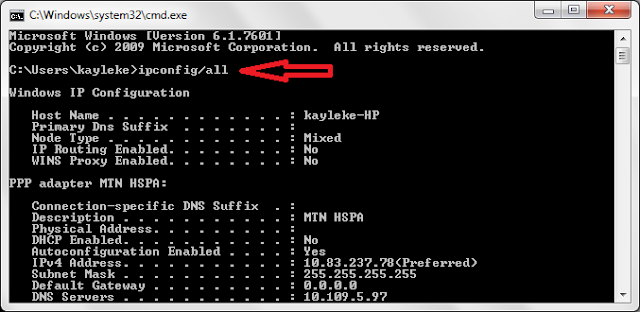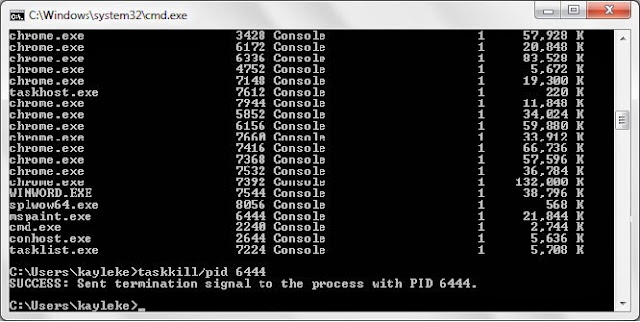This is the top most command for seeing the ip address, subnet mask and default gateway also includes display and flush DNS cache, re-register the system name in DNS.. This is a useful tool for viewing and troubleshooting TCP/IP problem.

Have a need to display operating system configuration information for a local or remote machine, including service pack levels? Then systeminfo is the tool to use. When I need to connect to a system that I am not familiar with, this is the first tool I run. The output of this command gives me all the info I need including: host name, OS type, version, product ID, install date, boot time and hardware info (processor and memory). Also knowing what hot fixes are installed can be a big help when troubleshooting problems. This tool can be used to connect to a machine remotely using the following syntax: SYSTEMINFO /S system /U user

- To view ip ,subnet mask address : ipconfig
- To view all TCP/IP information, use: ipconfig /all
- To view the local DNS cache, use: ipconfig /displaydns
- To delete the contents in the local DNS cache, use: ipconfig /flushdns
- To release IP, use : ipconfig/release
- To renew your IP, use: ipconfig/renew
Have a need to display operating system configuration information for a local or remote machine, including service pack levels? Then systeminfo is the tool to use. When I need to connect to a system that I am not familiar with, this is the first tool I run. The output of this command gives me all the info I need including: host name, OS type, version, product ID, install date, boot time and hardware info (processor and memory). Also knowing what hot fixes are installed can be a big help when troubleshooting problems. This tool can be used to connect to a machine remotely using the following syntax: SYSTEMINFO /S system /U user
3 - tasklist and taskkill
If you work with Task Manager (ctrl+alt+del) ,you can easily understand this. Task list is list of task which are running on windows currently. If you open any application,it will be added to task.
To List the Tasks type in cmd as :

To stop the Process or task ,there are two methods to do that:
To List the Tasks type in cmd as :
tasklistThis will show the list of task which are running as shown in the picture

To stop the Process or task ,there are two methods to do that:
Using Image Name:
We can kill the task using its Image Name as follows:
Using Process Id:
we can stop the process using its process id as follows :

4 - type
type is used to read the text document in command prompt . You can read multiple text in continuously
5 - netstat -n
We can kill the task using its Image Name as follows:
tasklist /im notepad.exe
Using Process Id:
we can stop the process using its process id as follows :
taskkill /pid 6444

4 - type
type is used to read the text document in command prompt . You can read multiple text in continuously
type filename.txt
5 - netstat -n
Need to know who (or what) is making a connection to your computer? Then netstat is the tool you want to run. The output provides valuable information of all connections and listening ports, including the executable used in the connections. In additon to the above info, you can view Ethernet statistics, and resolve connecting host IP Addresses to a fully qualified domain name. I usually run the netstatcommand using the
-a (displays all connection info)
-n (sorts in numerical form) and
-b (displays executable name) switches.
Tracert (traceroute) is used to determine the route taken by packets across an IP network i.e data packets from source to destination. Its syntax is (at command prompt):
c:/>tracert hostname.com
example:- c:/>tracert www.tescoideas.blogspot.com
You can force tracert to not resolve address to hostnames by using the -d switch, or set the desired timeout (milliseconds) for each reply using -w switch.
Nslookup can be run in two modes: interactive and noninteractive. Noninteractive mode is useful when only a single piece of data needs to be returned. For example, to resolve google.com:
To use the interactive mode, just type nslookup at the prompt. To see all available options, type help while in interactive mode.
Don't let the help results intimidate you. Nslookup is easy to use. Some of the options I use when troubleshooting are:
set ds (displays detailed debugging information of behind the scenes communication when resolving an host or IP Address).
set domain (sets the default domain to use when resolving, so you don't need to type the fully qualified name each time).
set type (sets the query record type that will be returned, such as A, MX, NS)
server NAME (allows you to point nslookup to use other DNS servers than what is configured on your computer)
To exit out of interactive mode, type exit .
8 - ping
This tool can be helpful with connectivity to other systems. Ping will test whether a particular host is reachable across an IP network, To ping a system, its syntax is (at command prompt):
c:/>ping www.google.com.
By default, ping will send three ICMP request to the host and listen for ICMP “echo response” replies. Ping also includes switches to control the number of echo requests to send (-n ), and to resolve IP addresses to hostname (-a ).
9 - gpresult - Used mostly in environments that implement group policies, gpresults (Group Policy Results) verifies all policy settings in effect for a specific user or computer. The command is simple to use, just enter gpresults at the prompt. It can also be used to connect to computers remotely using the /S and /U switches.
10 - netsh - Without a doubt the most powerful command line tool available in Windows. Netsh is like the swiss army knife for configuring and monitoring Windows computers from the command prompt. It capabilities include:
- Configure interfaces
- Configure routing protocols
- Configure filters
- Configure routes
- Configure remote access behavior for Windows-based remote access routers that are running the Routing and Remote Access Server (RRAS) Service
- Display the configuration of a currently running router on any computer
- Enable or disable Windows firewall:
netsh firewall set opmode disable
netsh firewall set opmode disable
- Enable or disable ICMP Echo Request (for pinging) in Windows firewall:
netsh firewall set icmpsetting 8 enable
netsh firewall set icmpsetting 8 disable
- Configure your NIC to automatically obtain an IP address from a DHCP server:
netsh interface ip set address "Local Area Connection" dhcp(For the above command, if your NIC is named something else, use netsh interface ip show config and replace the name at Local Area Connection).
As you can see netsh can do alot. Instead of re-inventing the wheel, check out the following Microsoftarticle for more info on netsh.
11 - arp :
This command display and modifies the IP to Physical Address translation table used by "Address Resolution Protocol".
Address Resolution Protocol protocol used to obtain a node's physical address. Suppose a node (source) wants to communicate with target node. Source sends arp request with target IP address target responds by sending its physical address.
example - arp -a (Displays current ARP entries table.)
There are many option with this commands
arp /? this help command give more option with description.





















0 comments:
Post a Comment